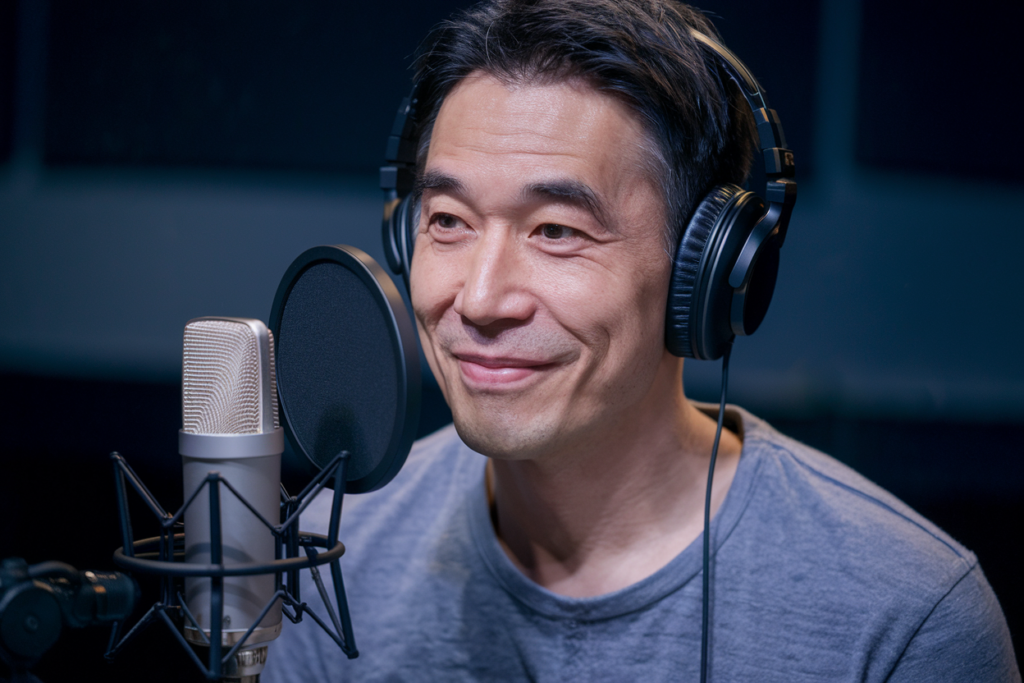Key Takeaways
- Pronunciation Mastery: Accurate pronunciation and understanding pitch accent are crucial for conveying the correct meanings in Japanese voiceovers. Minor mispronunciations can lead to significant misunderstandings.
- Cultural Context: Familiarity with cultural nuances and idiomatic expressions enhances relatability, making it essential for non-native speakers to research and consult native speakers during recordings.
- Technical Considerations: High-quality audio equipment and soundproofing are vital for capturing clear performances. Investing in professional recording tools ensures polished final products.
- Collaboration with Experts: Hiring experienced voice actors or language coaches can significantly improve the authenticity of recordings by leveraging their deep understanding of the language’s intricacies.
- Utilizing Technology: Employing advanced editing software helps refine recordings by eliminating noise and correcting errors, enhancing overall audio quality.
- Emotional Delivery Techniques: Developing skills in emotional tone adaptation is key to connecting with audiences, as nuanced delivery greatly impacts engagement in voiceover work.
Ever tried recording Japanese voiceovers and found yourself struggling with pronunciation or tone? You’re not alone. Many people face unexpected challenges when diving into this intricate art form, from mastering the unique sounds to capturing the right emotion.
Navigating the nuances of the Japanese language can feel overwhelming, especially if you’re not a native speaker. But don’t worry—understanding these difficulties is the first step toward improving your skills. In this article, we’ll explore common hurdles in recording Japanese voiceovers and share tips to help you overcome them, making your journey smoother and more enjoyable.
Overview of Japanese Voiceovers
Japanese voiceovers present unique challenges that require a deep understanding of the language’s nuances. Pronunciation plays a critical role; even minor variations can alter meanings significantly. For instance, the pitch accent in Japanese determines how words sound and their interpretations. This makes it essential for voice talent to master these subtleties to deliver authentic performances.
Tone also poses difficulties. The emotional context in which a phrase is spoken influences its impact. Whether you’re working with a voice artist for an anime character or a corporate narration, capturing the right emotion enhances engagement and relatability. An effective voice over actor adapts their delivery based on the target audience, ensuring clarity and resonance.
Moreover, cultural references can complicate recordings for non-native speakers. Understanding idiomatic expressions or culturally specific terms often requires additional research or guidance from native speakers. This insight helps voice over talent create more relatable content that resonates with Japanese audiences.
Lastly, technical aspects shouldn’t be overlooked. Clear audio quality is vital for any recording but becomes even more crucial when aiming for perfection in Japanese voiceovers. Investing in good equipment and software ensures crisp sound that captures every nuance of your performance.
Navigating these complexities demands patience and practice but mastering them greatly enhances your skills as a voice actor or artist in this vibrant field.
Common Difficulties in Recording Japanese Voiceovers
Recording Japanese voiceovers presents unique challenges that can trip up even seasoned voice talent. Understanding these obstacles helps you prepare effectively for a successful session.
Language Barriers
Language barriers often pose significant hurdles for non-native speakers. Japanese pronunciation and pitch accent require precise attention, as slight mispronunciations can alter meanings entirely. For instance, the word “hashi” means “bridge” when pronounced with one intonation but refers to “chopsticks” with another. This complexity demands that you master not only the words but also the nuances of tone and inflection. Engaging a language coach or practicing with native speakers can help bridge this gap and enhance your recordings.
Cultural Nuances
Cultural nuances greatly influence how messages are conveyed in Japanese. Certain expressions may carry connotations unfamiliar to non-Japanese speakers, making it essential to grasp cultural context. Phrases loaded with emotion or references specific to Japanese culture need careful handling to resonate with the audience authentically. Researching idiomatic expressions or consulting native speakers ensures your delivery aligns well with cultural expectations, enhancing relatability in your voiceover work.
Technical Challenges
Technical challenges also play a crucial role in achieving high-quality recordings. Clear audio quality is vital for capturing every nuance of your performance; any background noise can distract from the intended message. Investing in good recording equipment—like quality microphones and soundproofing—is essential for professional results. Additionally, understanding software tools used for editing and mixing ensures that you produce polished final products that meet industry standards.
Navigating these difficulties requires patience and practice, but tackling each challenge head-on will significantly elevate your skills as a voice artist in the vibrant world of Japanese voiceovers.
Solutions for Overcoming Recording Difficulties
Recording Japanese voiceovers can present unique challenges, but several effective solutions exist to help navigate these complexities.
Hiring Experienced Professionals
Hiring experienced professionals often makes a significant difference. Voice actors with a strong background in the Japanese language understand pronunciation, pitch accent, and cultural nuances. They bring an authentic touch to recordings that non-native speakers might struggle to achieve. Collaborating with skilled voice talent ensures your project resonates well with the intended audience, enhancing overall impact.
Utilizing Technology and Software
Utilizing technology and software can streamline your recording process. High-quality microphones capture clear audio, allowing for better delivery of intricate vocal performances. Additionally, editing software helps refine recordings by removing any unwanted noise or errors. Investing time in learning how to use these tools effectively will improve the final product significantly. Features such as pitch correction and sound effects can also enhance your voiceover projects, making them more engaging for listeners.
By implementing these strategies—hiring experienced professionals and leveraging advanced technology—you’ll overcome many common recording difficulties associated with Japanese voiceovers.
Case Studies
In the world of Japanese voiceovers, real-life examples can illuminate the complexities involved. Here are a few case studies highlighting common difficulties and effective strategies for overcoming them.
Case Study 1: Pronunciation Challenges
A voice artist faced significant hurdles while recording for an animated series. Despite having experience in voice acting, mastering pitch accent proved difficult. The character’s dialogue included words like “hashi,” which required precise intonation to distinguish meanings effectively. By collaborating with a language coach, the artist honed their pronunciation skills, leading to improved delivery and authenticity in performance.
Case Study 2: Cultural Nuances
Another example involves a voice actor tasked with dubbing a popular video game. The script was rich with idiomatic expressions that didn’t translate well into English. This created confusion during the recording process. The solution came through research and consultation with native speakers familiar with Japanese culture. By understanding these references better, the actor delivered lines that resonated more deeply with the target audience.
Case Study 3: Technical Difficulties
A project involving multiple voice over talents illustrated how technical challenges could impact quality. Recording sessions often captured background noise or inconsistent audio levels, affecting clarity and engagement in final products. Investing in high-quality microphones and soundproofing techniques transformed their recordings significantly. Using professional editing software also streamlined post-production efforts, resulting in polished outcomes that highlighted each performer’s unique style.
Case Study 4: Emotional Tone Adaptation
One particular voiceover project demanded emotional depth from its actors, requiring subtle shifts in tone based on context—an essential skill when conveying character feelings authentically. A talented voice over actor struggled initially but excelled after participating in workshops focusing on emotional delivery techniques tailored to Japanese narratives. Practicing various scenarios allowed them to adapt their performances effectively, enhancing overall audience connection.
These case studies demonstrate that understanding pronunciation nuances, cultural context, technical solutions, and emotional adaptability greatly influence success when recording Japanese voiceovers. Implementing targeted strategies empowers you as a client or talent to navigate these challenges effortlessly.
Conclusion
Recording Japanese voiceovers can be a complex journey filled with unique challenges. By understanding the intricacies of pronunciation tone and cultural nuances you’re already taking significant steps toward success. Each obstacle you encounter serves as an opportunity for growth whether it’s perfecting your pitch accent or navigating idiomatic expressions.
Investing time in quality equipment and seeking guidance from experienced professionals will enhance your recordings and boost your confidence. Remember that patience and practice are key in this vibrant field. As you embrace these challenges you’ll find yourself not just improving your technical skills but also creating more impactful connections with your audience through authentic performances.
Frequently Asked Questions
What are the main challenges of recording Japanese voiceovers?
Recording Japanese voiceovers presents challenges like mastering pronunciation, pitch accent, and cultural nuances. Non-native speakers often struggle with tone variations that can change meanings, and capturing emotional context is essential for effective delivery.
How does pronunciation impact Japanese voiceover work?
Pronunciation in Japanese is crucial because slight changes can alter meanings entirely. For instance, “hashi” can mean “bridge” or “chopsticks,” depending on intonation. Mastering these nuances helps ensure clarity and accuracy in voiceovers.
Why is tone important in Japanese voiceovers?
Tone significantly affects how messages are perceived in Japanese. Different emotional contexts require adaptations in delivery to resonate with the target audience, making it vital for voice talent to understand tonal shifts.
What role do cultural references play in voiceover recordings?
Cultural references and idiomatic expressions can complicate recordings for non-native speakers. To make content relatable, it’s important to research these elements or consult native speakers for accurate representation.
What technical aspects should be considered when recording?
Clear audio quality is paramount when recording voiceovers. Investing in good microphones and understanding editing software enhances performance by capturing subtle nuances effectively, leading to a polished final product.
How can individuals improve their Japanese voiceover skills?
Improving skills involves practice and collaboration with professionals such as language coaches or native speakers who provide insights into pronunciation and cultural context. Specialized workshops also help refine emotional adaptability during recordings.
Are there tools that can aid in the recording process?
Yes! Utilizing advanced technology like high-quality microphones and user-friendly editing software streamlines the recording process while enhancing sound quality—crucial for producing professional-grade voiceovers.
Can hiring professionals enhance my project’s quality?
Absolutely! Experienced professionals possess an understanding of pronunciation, pitch accents, and cultural nuances that directly contribute to creating impactful content tailored for specific audiences.







